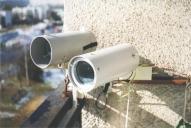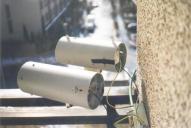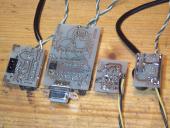Here you can read about the existing prototypes of Ronja and some
details abou their testing operation.
In this picture, you can see the sixfold fresnel lens (rectangular shape),
one 90mm diameter glass lens and six diodes HPWT-DH00 soldered on six
thick wires. Bending these wires causes alignment of the six beams into
exactly one direction. The case is made of blank printed circuit board.
- 20th August 2000: I tried to transmit 88MHz through a laser pointer laser, but realized
it simply doesn't work. So a FM receiver is unsuitable and low frequency carrier has to be used.
- 22th August 2000: I bought a cheap laser pointer and realized the spot is visible in the middle of the
night for some good 400 meters. Also proved that a retroreflector is a very good aiming helper,
when placed on the opposite side of the line.
- 2rd September 2000: when the spot is projected onto a white wall 700
meters distant, it is still faintly visible.
- 3rd September 2000: a retroreflector placed 500m away and illuminated
with a laser pointer is very well visible in the night. Distance estimate
using Derek Weston's Laserlink results says that Ronja 57 Sunprick should
work with full bit rate (57 kbps) for about 6 kilometers (!).
- 4th November 2000: Some guy on laser@qth.net determined the bandwidth of a laser pointer to be approx. 175MHz.
- 8th December 2000: Bruno
Schwander has tried out Ethernet fiber optics transceiver, where transmit diode was replaced with a visible laser diode and there were no optics added to the original fiber-optics interface. The
link worked allegedly up to two meters, reliably. How far will it go with optics? I can't
imagine. Look at the detailed description of the results.
- 12th December 2000: I got a RJ45 wire suitable for butchering and tampering with the Ethernet
waveforms.
- 9th January 2001: I found a suitable receiver circuit at Imagineering Ezine. The circuit is by David A. Johnson. I am studying it in order to build it, try it up and
possibly use it as a base for the Ronja 10M Bithazard Device.
- 29th January 2001: I junked up an old projector lens (objective) I bought about year earlier at some sale in a photo shop. It's a Meostigmat made by Meopta,
lens speed 1.4, focal length 70mm, input diameter 52.5mm. I had to disassemble it
first which was a bit tough as the input lens was stuck in the shaft. I had to
heat the case with two (!) soldering irons so it went hot and I was able to
shake the lens out. I cleaned it and tightly reassembled together again.
- 29th January 2001: I tested the Meostigmat out. It looks like The Ultimate Choice. I removed the aspheric miniature lens from my pointer and placed the bare
diode in the focus of the Meostigmat. The result was marvellous. Resulting point
in the distance was perfectly sharp. The beam was thick.
It shows a clear, sharp image. The image is slightly yellowish due to
someting that looks like and antireflex layer. There are four lenses inside,
two of them containing a gleu layer. So there are 8 glass-air transients and
six pieces of glass actually. However there is not much a light loss. I account
it to the antireflex. I intend to use it as a collimator for the laser diode in
order to get a thick beam with good properties. As it's optimized as a
projector lens the laser LED will go to the center of slide plane and the laser
beam will point into the infinity. I think the projector lenses might be good
stuff for laser beam expander.
- 7th February 2001: I thought out a concept of suitable holder which would
have fancy fine screw setting of direction and both focuses. Each optical setup
will consist of four thread sticks. On one end would be a board with cut-out
hole, in which the lens would be glued. On the other side, a piece of square
tin with small hole in the middle. There would be screwed up a tin case
containing the receiver or transmitter and circuitry.
The objective would be holded by two U-profiles cut out a little bit in
the middle in a V-shape to stay firmly on the cylidrical shape. They would be
bolted together with additional two screw sticks. The focus would be
obviosly easily settable.
On the screw sticks, between the front and rear, would be nutted the holder.
Adjusting the nuts would shift the direction in two axes slightly. Rough
shifting would be done in two additional screws of thick caliber. The holder
would fit onto a wall with four holes with jacks in them. I think it will be
stable enough to operate safely even in high wind.
- 1th April 2001: I got two Ethernet cards that both featured AUI connectors.
I connected RX+ of one with TX+ of the second, RX- of the first with TX- of the
second, and vice versa, and determined it works realiably and cleanly.
Amd they run full duplex, although they are not full duplex cards! (AUI is
always full duplex, the only thing where you can opt for full or half
duplex is TP, and coax is always half duplex).
There is even +12V source at the AUI, and a data line impedance I like to
see there. On top of it, thanks to full duplexity, there could be error
correction codes in the future. Conclusion: AUI is 100% cool.
I also determined it is always possible to get AUI from a coax network card
by an inexpensive and easy hardware hack: you simply cut the signal path
between the chip and coax transceiver.
- 2th April: I was trying to build a 1MHz square wave oscillator for idle wave
on the link. I've tried a two-transistor multivibrator, without success. I don't
wonder: I've found a state in which the multivibrator stops and doesn't oscillte. So I made another design with 74HC132 (Schmitt trigger NAND), a 10k resistor
and 100pF capacitor, and it works just fine.






